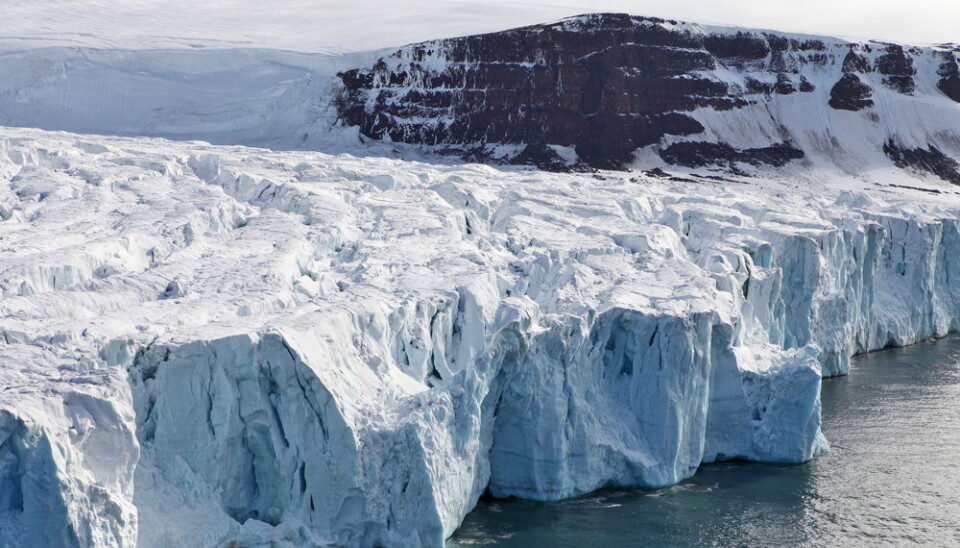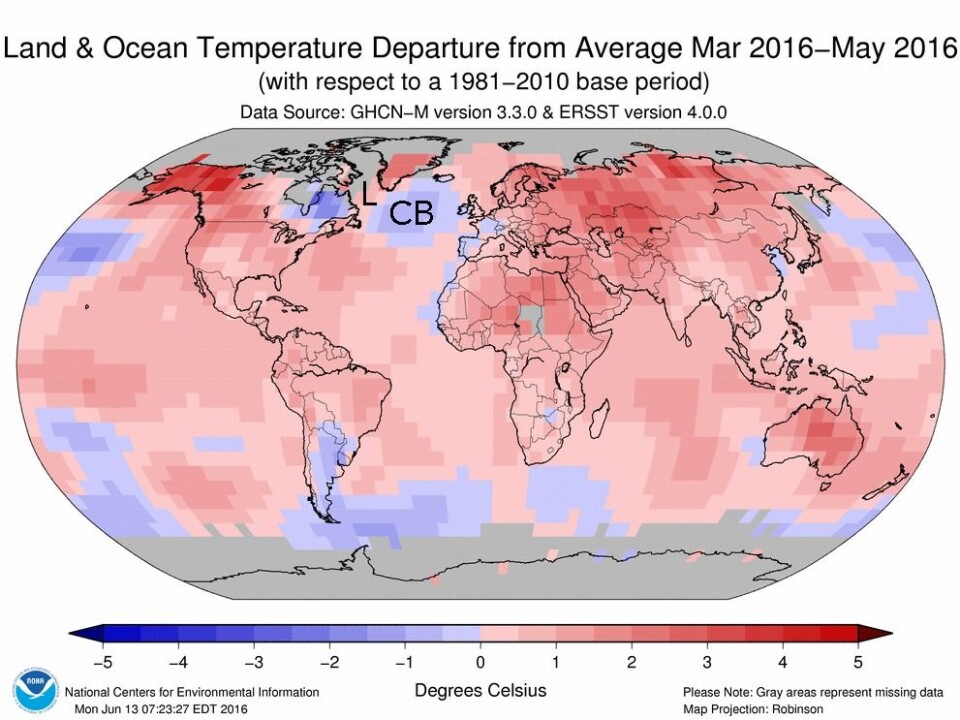
Melting Greenland ice has not slowed down ocean circulation
GREENLAND: Two new studies suggest that meltwater from the Greenland ice sheet has not slowed down ocean circulation in the North Atlantic and may not be behind the ominous cold patch of ocean called the ‘cold blob’.
Many climate scientists have been both worried and puzzled by a patch of anomalously cold water in the North Atlantic Ocean--the so-called ‘cold blob’, which emerged a couple of years ago.
While the surrounding ocean has been getting warmer and the Earth has on average been getting hotter, this patch of ocean just south east of Greenland has remained stubbornly cold.
Many scientists think that cold, fresh meltwater from the Greenland ice sheet is at least partly to blame for this patch of cold ocean. And that it could be an indication of the shutdown of the large ocean conveyor belt the so-called Atlantic Meridional Overturning Circulation (AMOC) in the Atlantic Ocean, which brings warms water and weather up from the tropics to northern Europe (see Fact Box).

But two new studies published in Nature Geoscience and Geophysical Research Letters suggest that there is no cause for concern just yet.
Read more: Greenland melt linked to weird weather in Europe and USA
No imminent shutdown in ocean circulation
Together, the two new studies report that Greenland ice melt has not had any significant impact on ocean circulation in the North Atlantic so far, and that the ‘cold blob’ is unlikely to indicate an imminent shutdown in ocean circulation that some scientists had feared.
“There is a lot of hype around the reduction of the AMOC, but there is really no evidence of that happening any time soon.” says research leader, Jens Hesselbjerg Christensen from the Danish Meteorological Institute (DMI).
“These two studies really illustrate that to have a strong impact on ocean circulation we need a very heavy release of freshwater output from Greenland, and this can’t be provided as it is right now,” says Christensen, who was not involved in the new research.
Greenland melt has had no impact on ocean circulation, yet
The two studies took different approaches to investigate ocean conditions in and around the ‘cold blob.’
The Nature Geoscience study used a combination of observations of the amount of water lost from Greenland and a computer simulation to see what effect this fresh (less salty) meltwater has had on ocean currents in the Labrador Sea, which is to the west of the ‘cold blob’.
“The volume of the additional fresh water entering the surrounding ocean is known. But we didn’t know where this water goes. Does it accumulate somewhere?” says lead-author Claus Böning, from the GEOMAR Helmholtz Centre for Ocean Research, Germany.
They found that even though Greenland is pumping more and more fresh water into the sea making it slightly less salty as a result, the overall trend is very small and meltwater from Greenland has not had any significant impact on deep ocean convection to date.
“The majority of the water flows around the Labrador Sea, and a significant fraction leaves the sub-polar North Atlantic altogether by flowing out with the Labrador current along the American coast to the south,” says Böning.
Second study confirms modelling results
The second study confirms this using observations of ocean temperatures in the nearby Irminger Sea, south west of Greenland at the heart of the ‘cold blob’. Here, scientists deployed an ocean mooring in 2003, which measured temperature down to a depth of 3000 metres every day.
If meltwater from Greenland had slowed down ocean convection, they would have expected to see warmer temperatures throughout the water column. But instead they discovered that the water was uniformly cold down to a depth of 1400 metres.
“There is no sign of a shutdown of deep convection, in fact it has actually increased,” says Laura de Steur from the Norwegian Polar Institute, who co-authored the paper published in Geophysical Research Letters.
A cold Arctic winter created the ‘cold blob’
But if Greenland melt has not had a significant impact in the region just yet. What is causing the ‘cold blob’? For an alternative explanation, de Steur and her colleague looked to the weather.
“We found that the winter of 2014 to 2015 was marked by exceptionally deep convection,” says de Steur. This is significant, because it was around this time that the ‘cold blob’ emerged and at the same time, the northern North Atlantic Ocean experienced a particularly cold winter.
“We can explain this deep convection and hence the cold temperature; we found out that it is simply atmospheric forcing--basically the cooling of the ocean by the atmosphere--as the winter was exceptionally cold during that time over the North Atlantic,” says de Steur.
No effect now, but what of the future?
But even though the Greenland ice sheet has not yet had a significant impact on ocean circulation in the Labrador or the Irminger Seas, this situation could change in the future, says Böning.
“The melting will continue and maybe it will accelerate,” he says. “But the effect is delayed.”
So far he estimates that an additional 5000 cubic kilometres of fresh meltwater has entered the North Atlantic Ocean from Greenland. This is about one quarter of the volume of the Baltic Sea. Using a computer model he predicted how much additional meltwater would be needed before ocean circulation is affected.
“We estimate that it takes about four times as much accumulation in the Labrador sea before a significant effect will occur, and that may happen in the next 20 to 30 years,” he says, and adds “of course there is uncertainty, because we don’t know exactly how the melting trend will go in the next 20 years.”
Read more: Climate models underestimate rapid ice melt events on Greenland
Controversy set to continue
De Steur agrees that additional meltwater is likely to have an effect in the future, but she puts the time-scale of this happening at decades to hundreds of years from now.
“In the long run, maybe more than decades or even hundreds of years into the future, if the Greenland ice sheet continues to melt and even accelerates, then I think it will have a significant effect on ocean circulation,” she says.
“I don’t think that we can really predict what the effect will be yet, because so far we have a very limited understanding of how the AMOC works,” she says.
All agree that there are still many more questions for climate scientists, glaciologists, and oceanographers to answer before we can say if, how, and when ocean circulation in the North Atlantic could be interrupted by a melting Greenland and how significant the ‘cold blob’ may be in the future.
Scientific links
- Emerging impact of Greenland meltwater on deepwater formation in the North Atlantic Ocean. Nature Geoscience. Doi:10.1038/ngeo2740
- Strong winter cooling over the Irminger Sea in winter 2014–2015, exceptional deep convection, and the emergence of anomalously low SST. Geophysical Research Letters. DOI: 10.1002/2016GL069596





